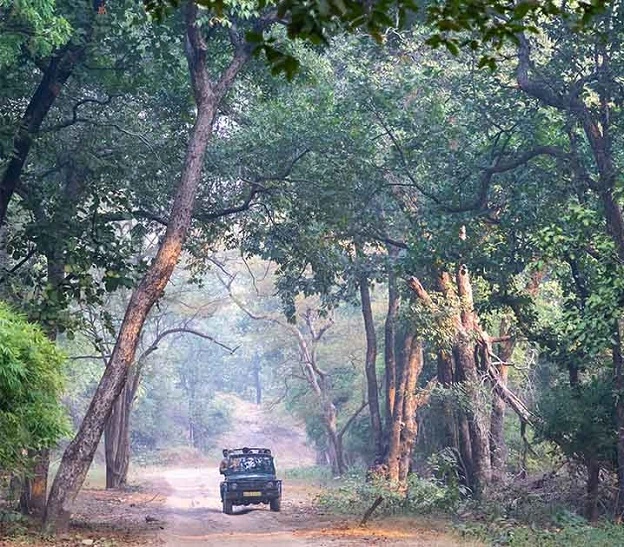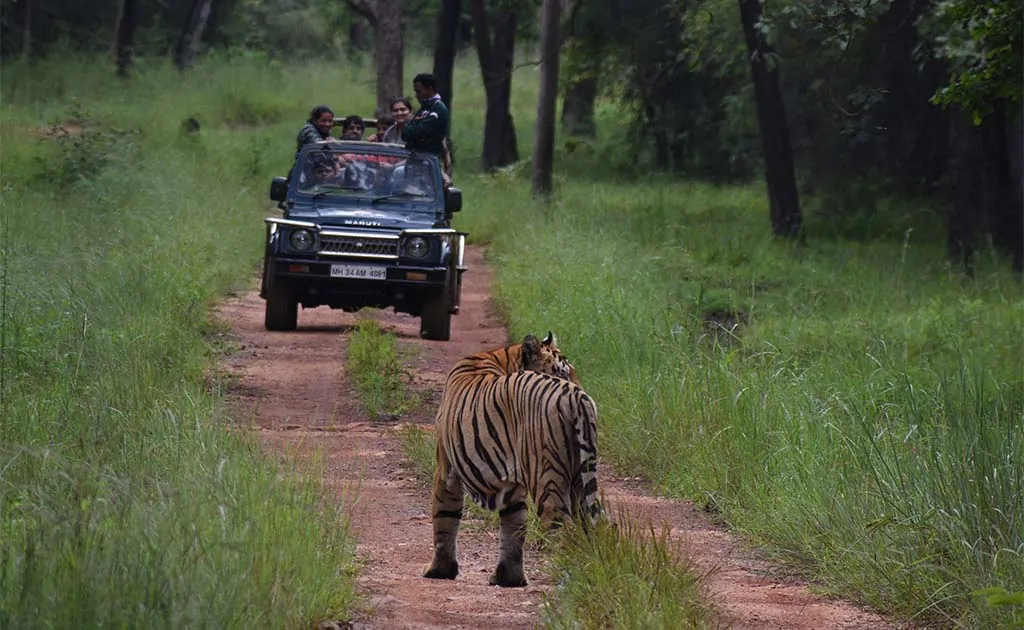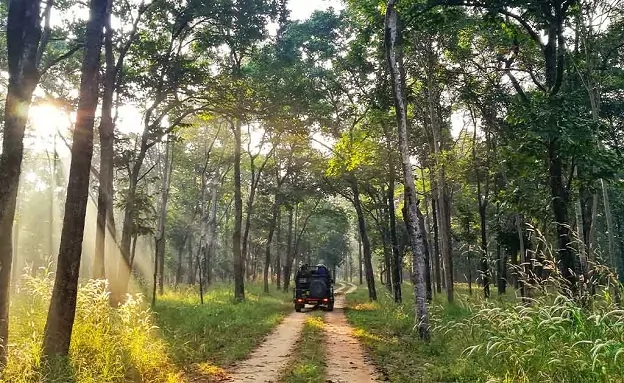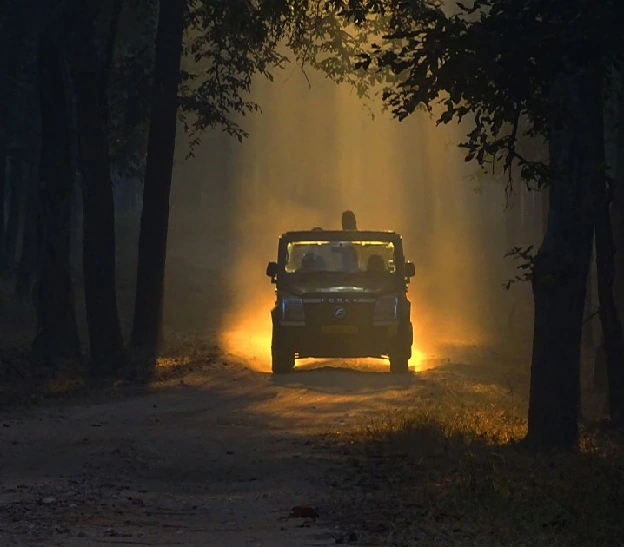What you will experience with us?
- Rich Biodiversity of India
- Memorable tiger safaris with our naturalists
- Stay in sustainable jungle lodges
- Interactions with the local community
An adrenaline pumping Tiger Safari in India can transport you to a whole new world of adventure. Spotting the Royal Bengal Tiger in the wild is an experience parallel to none. The regal strides, the gracious demeanour, the royal stripes blending in the wilderness; make it an exclusive wildlife experience to cherish for a life time to come.
India with the highest population of wild Tigers and 53 Tiger reserves is the best place to see tigers in the wild. India is now home to over 3100 wild tigers, which is more than 2/3rd of the total world tiger population, making it the best place for Tiger Safari.
With the largest stronghold of tiger population in the world, India offers one of the most exclusive Tiger Safari experiences. Tiger sightings are of course a matter of chance, yet some parks offer higher likelihood of sightings due to the landscape & forest type. With 53 Tiger reserves in India, the country offers varied options across the length and breadth of the country.

Bandhavgarh National Park is located in Vindhya hills of Umaria district. Declared Tiger Reserve in 1972, under the Project Tiger and Wildlife Protection Act it is now one of the preferred parks for Tiger Safari in India that includes photographing and tracking Tigers in wild.
Bandhavgarh National Park was a Shikargah, or game reserve for the Maharajas of Rewa and their guests. Spread across an area of 1150 sq. kms, Bandhavgarh has one of the highest density of tigers in the world. Bandhavgarh is the original home to Mohan, the father of all white tigers in captivity today. Bandhavgarh’s famous tigers are Sita, Charger, Dotty and Spotty. The episodes of Dynasties, a documentary by BBC, were filmed in Bandhavgarh.
Best Time to visit Bandhavgarh National Park:
October to June
Tiger safari Tour Duration:
Tailor made as per need; suggested duration is minimum 6-7 nights.
Highlights of Bandhavgarh:
Tiger Safari, Bandhavgarh Fort, Ancient Manmade Caves and Shesh Shaiya.
Best way to reach Bandhavgarh National Park:
Fly to Jabalpur and drive for 3 ½ hours to reach the National Park. Jabalpur is well connected from all major towns in India, hence making it an ideal town to reach Bandhavgarh National Park.
Tadoba National Park has gained immense popularity in the recent years as the top park for tiger sightings in India. Tadoba is a dry deciduous forest offering better visibility throughout the forest and hence increasing your chance for a good sighting.
The park has been well maintained with plenty man-made water saucers, which act like magnets for tigers & other wildlife in the hot months of summer. Tadoba has extreme weather conditions where the temperature happens to soar close to 45-50 degree Celsius in peak summers.
Tigers can be spotted on the tarmac road leading to the park and even lying lazily near the man-made water sources. Some of the famous tigers of Tadoba are Maya, Choti Tara, Sonam, Bajrang and Madhuri.
Best Time to visit Tadoba National Park:
Throughout the year
Tiger safari Tour Duration:
Tailor made as per need; suggested duration is minimum 6-7 nights.
Highlights of Tadoba:
Tiger Safari, Black Leopard, Magan khadi & Ramdegi Temple.
Best way to reach Tadoba National Park:
Fly to Nagpur and drive for 3 hours to reach Tadoba National Park. Nagpur is well connected from all major cities in India.


This surreal tiger country with its magical landscape is a feast to the eyes. The large open meadows ensure that the chances of spotting tigers are high. Though Kanha’s greatest achievement has been the preservation of Hard Ground Swamp Deer or Barasingha, from near extinction, Kanha’s meadows sustain large numbers of Chital, Sambar, Barasingha, and Gaur, which in turn support populations of predators and co-predators like Tigers, Leopards, Wild Dogs, Jungle Cats, and Foxes. A shutterbugs delight, Kanha is an ideal place to capture magical tiger shots and is a popular destination for photography tours. David Attenbrough’s documentary ‘Tiger’, a very well made film on the tigress of Kanha, ‘Laxmi’ was shot in this park.
Best Time to visit Kanha National park:
October to June
Tiger safari Tour Duration:
Tailor made as per need; suggested duration is minimum 6-7 nights.
Highlights of Kanha:
Tiger Safari, Sal Forest & Meadows, Barasingha, and over 350 species of birds.
Best way to reach Kanha National Park:
Fly to Jabalpur and drive 3 hours. Jabalpur is also well connected to all the major cities in the country and hence can be conveniently reached through road.
This tiger reserve boasts of a dry deciduous forest with lush, verdant teak forests. A land of delightful splendor where myriad flora and fauna inhabit these stunning jungles. Some of the inhabitants are Tigers, Indian leopards, Sloth bears, several varieties of Deer, Nilgais, Chinkara, Wild Dogs and Gaurs. Pench is an idyllic land for bird watching, boasting of over 210 species of birds, including migratory birds.
Well connected with Kanha National Park through the Pench-Kanha corridor, the park offers the best of both the worlds. The late tigress Collarwali, is known worldwide for giving birth to the maximum number of cubs in the wild, till date and getting Pench on the world Tiger map. Spy in the Jungle is a film narrated by Sir David Attenborough, which got filmed in the mystical locales of Pench.
Best Time to visit Pench National Park:
October to June
Tiger safari Tour Duration:
Tailor made as per need, suggested duration is minimum 6-7 nights.
Highlights of Pench:
Tiger Safari, Leopards, Wild Dogs and Teak Forest.
Best way to reach Pench National Park:
Fly to Nagpur and take a road drive of 3 hours. Nagpur also makes for a convenient road trip destination as it is well connected from all major cities in India.


In 1994 Panna National Park became India’s 22nd Tiger Reserve. Panna is situated at the junction of the Gangetic plains and the Deccan peninsula. The Panna Hills provide the catchment area for the Ken River, which is the life line of the park. It is home to over 40 species of mammals and over 300 species of bird and along with numerous butterflies and reptiles, it makes for an ideal wildlife paradise. The area hosts the second largest number of small cat species in the world.
It is predominantly an open forest, offering great opportunity to see the Tiger and other mammals. It also supports closed canopy forests, open forest with short grass and undercover, open Savannah woodlands which reflect sub Saharan habitats, tall grasslands and degraded scrub. Panna has been home to a highly successful Tiger relocation project. From near extinction the tiger population has now reached a healthy figure of 50 plus.
Best Time to visit Panna National park:
October to April
Tiger safari Tour Duration:
Tailor made as per need, suggested duration is minimum 6-7 nights.
Highlights of Panna:
Tiger Safari, Leopards, Crocodiles, Boat & Night Safari.
Best way to reach Panna National Park:
Fly to Khajuraho and drive for 45 minutes to reach the park. Khajuraho airport is connected from Delhi with frequent daily flights.
The electricity supply is 230 – 240 volt, with three round pin plugs. Most western visitors will require an adaptor. Adaptors are available on request at all our lodges. Many of our lodges have international sockets in the rooms. There are ample sockets available for charging cameras etc.
All our lodges have basic internet connection available. We encourage our guests to connect to nature & disconnect from the world, when they visit our lodges. Internet speed is not the best but good enough for general work and correspondence. Internet may not be reliable at all times as breakdowns take time to fix as we are remotely located.
A delectable spread of vegetarian and non-vegetarian food is served at all the lodges; Breakfast is usually served on safari. Lunch and Dinner is a choice between both Indian & continental cuisines. Pure Vegetarian and other special food requests are taken care of on prior information. Chicken, mutton or fish are available for all major meals at the lodges. Beef and pork are largely unavailable. We source fresh non vegetarian and is safe to eat. Team can handle special dietary requirements if informed at time of booking the Tiger Safari.
We request guests to refrain from tipping any individual staff at the lodge. In case you wish to show your appreciation in form of tipping, tip boxes have been placed in the offices. The tip collected is shared between the operations staff, junior staff and many behind the scene members.
Note - Naturalists, Nature Guides and drivers are not part of the common tipping and may be tipped directly. Our lodges do not charge a service fee.
The Indian currency is the rupee, which is made of 100 paise. Major currencies such as US dollars, British pounds and Euros are easy to exchange throughout India. Most international airports throughout the country will have money exchange counters and also all cities have money exchange agents. Our wildlife lodges can change small amount of major currencies and large amounts on a days’ notice. ATMs are also readily available throughout the country, but near the parks they may run out of cash frequently. All our lodges also accept master/visa credit and debit cards.
Indian Tiger reserves have limited jeep carrying capacity, hence only a limited number is allowed for entry. The ticket sales open online, 90-120 days in advance for most of the popular parks, and these tickets get sold out within a day or two of opening. For peak periods the tickets sometimes get sold out within hours of opening. If booked timely, it not only safeguards your entry ticket on a preferred date, but also ensures that you also get the best zones within the park leading to a memorable Tiger safari experience.
All Tiger safaris in India require a forest guide in the jeeps, to monitor and regulate the excursion. There is a high probability that they are not well versed with flora & fauna and if they are, only a few speak English. This rule is in place, so as to encourage local employment opportunities, and integrate locals in the emerging eco-tourism sector. Over the years many have become experts in interpreting the flora and fauna, and have even learned English, however they are assigned based on a roster and a different guide is provided for every safari. To make your experience personalized and without counting on your luck to get a guide of your choice, it is advised to opt for an experienced English speaking naturalist who can become an interpreter between you & the jungle.
All the popular tiger reserves have many zones open for tourists. Park tickets are available zone wise. It is best to do a mix of different zones to experience the entire park. Some zones in the same park tend to have a different habitat, resulting in diversity of flora & fauna. Tiger sightings also tends to move around from one zone to another, depending on season centric factors such as a tigress with a new litter, water and food availability, etc. Many parks also offer zones in both core and buffer forest of the tiger reserve.
In majority of the tiger reserves the temperature looks warm or moderate, and many guest come prepared accordingly. However, even in months like October and April which are considered warm months, the morning safari can get cold, as it gets very windy in an open jeep driving through a forested area. In these months the first two hours of the safari can be really cold, but once the sun is out it gets warm and sometimes hot. November to March come with lovely, sunny days; but Tiger safaris can get bitterly cold. So during this period good warm clothes are suggested. Most good safari operators also provide blankets and hot water bottles for these months, to make the safari comfortable. Therefore, it is best to come prepared according to the weather and pack appropriate clothing.
Most guests come to the Tiger reserves hoping to see a wild tiger. For many of them it’s on their bucket list of things to see or do. Sighting wild tigers is a matter of chance, though a lot also depends on the weather, season and your naturalist and driver. Sometimes you hit the jackpot on the first drive, and sometimes never. Sometimes you do see a tiger, but it’s not a great sighting. It may be very far, or one where the tiger vanishes into the thicket, before you could get a chance to notice it. Therefore, it is best to give yourself a minimum of five-six nights with eight to ten drives; spread over two tiger reserves; if not more. This will ensure your chances for a great sightings and shall make for a memorable Tiger Safari in India. You are spending a lot of time & resource to reach the parks, so it is wise to give yourself a few extra days.
| National Park | Location | Area | Tiger Population | Landscapes | Focus Species | Time to visit | Nearest airport |
|---|---|---|---|---|---|---|---|
| Madhya Pradesh | 940 km² | Dense Sal and Bamboo forests with rolling grasslands, offering varied landscapes | Tigers, Leopards, Sloth Bears, Wild Dogs, Swamp Deer, Fox, Jackals, Gaur and over 300 bird species | ||||
| Madhya Pradesh | 1,536 km² | The park is set in a rich Sal forest with ancient caves and ruins that add a historical dimension to the safari. | Tigers, Gaur, Sambhar Deer, Foxes and over 270 bird species. | ||||
| Madhya Pradesh | 758 km² | Dry Deciduous Teak forest it is a mix of dense, open meadows, and riverine habitats, offering an excellent opportunity for wildlife sightings. | Tigers, Leopards, Wild Dogs, Jackals, Gaur, Sloth Bear and over 250 bird species. | ||||
| Madhya Pradesh | 542.67 km² | The Ken River runs through the park, offering stunning landscapes and increased chances of tiger sightings near the riverbanks. | Tigers, Leopards, Sloth bears, Hyenas, Crocodiles, Jungle Cat and a variety of bird species, including the endangered Indian vulture. | ||||
| Madhya Pradesh | 1,427 km² | Its dense forests and rugged terrain make it perfect for those seeking a more off-the-beaten-path experience | Tigers, Leopards, Wild Dogs, Sloth Bears Gaur, Giant Squirrels, Black Bucks, Crocodile and a wide variety of birds including migratory water birds. | ||||
| Maharashtra | 625 km² | Tropical dry deciduous forest with Teak and Bamboo as the major plant species. It is a more open forest offering better visibility and has several lakes. | Tigers, Leopards, Sloth Bears, Foxes, Jungle Cat, Wild Dogs and a variety of birds. |






Great India Tiger Safari covers three Tiger parks of central India – Tadoba, Kanha & Bandhavgarh. This safari is ideal for a wildlife enthusiast focusing on Tiger. Together they are home to close to 20% of wild tigers in India. These 10 days Great Indian Tiger Safari also gives wildlife seekers get the best of the world by getting a chance to witness a starkly different terrain across these 3 parks.
This Tiger tour in India is ideal for a wildlife enthusiast focusing on the Tiger as it covers the three best National Parks of India – Bandhavgarh, Kanha & Pench. Each park offers a unique habitat, hence making them ideal tiger destinations for being explored by wildlife enthusiasts, who come to witness the wildlife of India through this popular tiger tour in india.
This tour has been designed carefully to give you an insight of the very best of Wild India - Satpura, Pench, Bandhavgarh & Kanha, offering beautiful scenic views, mesmerizing rivers, and the finest Tiger Sightings. The Tour will take you through the ravine’s of Satpura to the Lush green Meadows of Kanha to the Deciduous forests of Pench & Bandhavgarh.





It is suggested to book a Tiger Safari at least 130 days in advance as the park permits open that time. This will give an opportunity to get the preferred zones for Tiger Safari.
80% population of Tigers around the world are found in India only. A tiger safari in India offers a good chance to see the majestic Bengal tiger in the wild, experience India's diverse ecosystems, and immerse yourself in both adventure and conservation efforts.
Please refer to the link for details : https://www.pugdundeesafaris.com/terms-and-conditions
Yes, visa is required for travel to India. For some countries, visa on arrival option is also there but recommend securing the same in advance.
While price may vary on travelling dates, a comfortable accommodation with all meals and two private safaris would cost about USD 600-800 per day based on 02 guests travelling together. If 4 guests are travelling together the prices will go down substantially as safaris can be shared.
A typical day on a tiger safari in India is an exciting and immersive experience, offering a chance to explore the wilderness, observe wildlife in its natural habitat, and possibly spot the elusive Bengal tiger. You start very early to enter the park at sunrise for morning safari that gets over by 11 AM. Afternoon safari starts around 2.30 PM after lunch and ends by sunset. Timings tend to change with season.
A standard tiger safari package includes 2 safari drives per day, one in the morning and one in the afternoon.
Open jeeps are safe for tiger safaris in India, as long as you follow the park guidelines and protocols. Guides and drivers are well-trained to handle situations ensuring a safe and enjoyable experience.
Jeeps are smaller in size with the capacity of 4-6 people and are preferred for better view & personalized experience. Canters are bigger in size with a capacity of 16-18 people; preferred by big groups and is cost efficient.
Yes, night safaris are available in some buffer zones of national parks in India like Bandhavgarh, Kanha, Satpura,Panna & Pench. It starts around dusk and gives the opportunity to see nocturnal animals such as leopards, jackals, hyenas, owls, civets, porcupines and nightjars which are rarely active during the day
Strict park regulations are in place for Tiger Safaris to ensure the well-being of both tourists and wildlife. Vehicles are only driven by experienced and registered drivers, also every vehicle has a mandatory park guide.
Children are allowed on safaris though recommended minimum age is 4-5 years as at times, weather is very cold during the safaris and safaris can get bumpy.
Guests are never allowed to get down from the vehicle except in designated areas for breakfast or for using the restrooms at designated places.
There are some basic rules to follows like, no standing up inside the vehicle or leaning out, restrictions on loud noises, flash photography, maintaining minimum distance between vehicles and from large animals like tigers and elephants and off-track movement. Visitors are briefed on these rules before entering the park
No, Tap water in India is generally not safe for drinking. Good lodges provide the RO purified / filter water safe for drinking in re-usable flasks or bottles.
Neutral-colored clothing with lightweight and breathable fabrics is suggested. Long-sleeved shirts and pants are highly recommended to protect your skin from sun exposure & mosquitoes. Early morning safaris and evening safaris can get chilly, especially in the winter months, you are advised to carry multiple layers along.
A wide-brimmed hat, sunglasses, comfortable footwear, light weight jacket, Insect Repellent, Sunscreen, Hand Sanitizer, Personal Medications, Binoculars, Camera are some basic requirements
It's always a good idea to carry some cash when traveling to tiger safari parks in India as they are remotely located in less urbanized areas. Carry enough cash to cover local expenses, such as tips or small purchases. Best to use ATMs near airports on arrival to the closest city.
Credit cards are not widely accepted for payments at the park gates, for safari permits, or for local vendors. While lodges accept most credit cards, most remote areas near tiger reserves and national parks rely heavily on cash transactions.
While it's not strictly necessary to have specialized camera equipment for a tiger safari in India, having the right gear will significantly enhance your ability to capture wildlife moments, especially for close-up shots of tigers and other animals in their natural habitat
You may rent basic photography equipment on arrival In India or around the parks, but availability can vary depending on the destination and the specific tiger reserve you’re visiting.
Drones are not allowed for use in most tiger reserves and national parks in India. The use of drones for aerial photography or videography is heavily regulated by the Indian government, and there are strict rules that prohibit drone use in protected wildlife areas.
Yes, photography guides are available for assistance on tiger safaris. These guides are experienced photographers who can help you capture wildlife photos and offer specialized guidance tailored to your photographic interests and skill level. The same has to be booked at an additional cost on prior information.
It is best to discuss the same with your local medical practitioner much in advance from your travel date. There is no compulsory vaccination required to travel to India.
Yes, basic medical facilities are available near most major tiger reserves and national parks in India, for more serious matters we have to travel to the closest towns.
Yes, insect repellent is recommended especially for protection against mosquitoes during monsoons and summers. The most effective repellents are those containing DEET (20%-50%) or Picaridin (20%), with oil of lemon eucalyptus (OLE) or citronella being good alternatives for those preferring natural options
Yes, it's important to be mindful of local customs and etiquette to ensure respectful and responsible behavior towards the local communities like dress modestly, respect tribal groups, avoid public display of affection, water conservation, seek permission before taking pictures and entering places of worship.
Yes, you may visit the cultural sites, villages and communities nearby. You may also plan a visit to school, temples, local handicraft shops to enhance an enriching and authentic experience
You have the chance to purchase unique handicrafts and souvenirs that reflect the local culture and artistry. Whether it's tribal paintings, hand-woven textiles, wooden carvings, or traditional jewelry, these items make meaningful mementos of your travels while supporting local artisans.
In India, the most commonly spoken language by guides and staff at safari lodges is Hindi followed by their tribal/local language. Lodge managers and naturalists communicate in fluent English, however others are able to manage with broken English (like park guide, driver or housekeeping staff)
Yes, many tiger reserves offer opportunities for visitors to engage in community-based activities that provide a deeper understanding of the local culture & support sustainable tourism. These may not be available all the time.

A safari specialist at Pugdundee Safaris. Her journey into the world of wildlife tourism began over 15 years ago and she has extensively travelled to wildlife destinations in India. She has been guiding travellers through out India’s most iconic wildlife sanctuaries and national parks, including Bandhavgarh, Tadoba, Pench and Kanha, which are amongst the top places for Tiger Safari in India.
She curates various experiences for all kinds of travellers, whether avid photographers, nature lovers, or those who simply want to experience India’s wildlife up close. While ensuring that your travel experience is comfortable, safe, and enriching, each tour is carefully designed with sustainability in mind, from minimizing environmental footprints to supporting local conservation projects and promoting eco-friendly travel practices.

An experienced sales and operations professional with a demonstrated history of over 3 decades working across the travel industry, supporting sales services, and operations.A senior-level professional with a proven track record of assisting world-renowned wildlife enthusiasts and photographers, for safari & bespoke expeditions.
Skilled in business planning, coaching and training, Sangeeta carries an exemplary track record of implementing best practices across organizations. With an in-depth knowledge of wildlife and a keen eye for detail, she ensures every safari is an exceptional and unforgettable experience. She is dedicated to creating journeys that are not only enriching but also aligned with sustainable practices, preserving the landscapes that make these remarkable encounters possible.
24 weeks ago
I want to thank Pugdundee Safaris and in particular Sangeeta Kakaria for all the time, attention and efforts in planning our "trip of a lifetime". It far exceeded our expectations. The attention to detail was evident in every aspect of our tour, starting with Punam Ghandi as our guide. ... Read More
We thoroughly enjoyed Punam's company: her knowledge, sense of humour and in general her personality. She showed us many interesting sites in both Delhi and Agra, creating memorable experiences for all of us. We were sorry to part with her in Agra. Pramod Kumar joined us in Agra and ensured a smooth transfer to our driver, Rahul, in Jhansi. Rahul got us safely to all our destinations and was sensitive to our needs, not to mention his excellent driving skills. We felt very comfortable with him behind the wheel. As for the lodges, their staff and the naturalists, where do I start? We loved all the accommodations - from the rustic lodge at Ken River to the Treehouse Hideaway at Bandhavgarh to the Earth Lodge at Kanha. All were unique in their own way, and each provided exceptional attentive hospitality and great cuisine. The naturalists were a wealth of information and made each drive an unforgettable experience. We loved the cool morning drives all bundled up in excitement with our blankets and hot water bottles experiencing some of the most beautiful parks and landscapes - the tigers were a bonus (and we saw many.) The local guides in both Orccha and Khajuraho were informative and the sites themselves very impressive; it was the perfect transition from the bustling cities and before the serene parks (and we had the added benefit of a little shopping at both sites.) I also want to commend Sangeeta for arranging Pugdundee staff to attend all our transfers from Delhi to Agra to Jhansi, Orccha, the airport etc. - that detail took all the stress out of traveling for us. All attending staff were punctual, polite and helpful. In summation, our trip really couldn't have been any better. Thank you Pugdundee Safaris. We hope to be back! Read less
24 weeks ago
I used Pugdundee Safari's to organise a significant part of my latest trip to India. I found them to be easy to communicate with, very efficient and pleasant. I stayed in three of their Eco Lodges at Tadoba, Pench and Satpura National Parks. These were all excellent, very comfortable with excellent accommodation following the highest ecological principles. The company takes excellent care of all its staff and puts a lot of training into local villagers. The organised safaris with our own naturalist could not have been any better. ... Read More
The company also organised my transport between the lodges, the drivers were all skilled and the rides comfortable. I would wholeheartedly recommend this company to any travelling to India who wanted to experience the joy of visiting the national Parks.
In the office, Sangeeta Kakaria was amazingly helpful! We saw this tiger in Tadoba, the leopard in Pench. The cottages are the accommodation in Waghoba Lodge near Tadoba. ... Read less
35 weeks ago
We stayed at King's Lodge and Kanha Earths Lodge in March of 2024 for about a week. We had an incredible experience and hope to return. The properties are different, but both are well kept, beautiful and prioritize the social, economic and environmental wellbeing of their neighbouring communities. The food at both properties was wonderful and although my family and I ate the Indian food, some guests requested western food and the chefs went out of their way to accommodate them. ... Read More
We did a total of 9 safari's and were lucky to see 5 tigers, a sloth bear and a lot of other amazing wildlife. Our naturalists Raju and Yash were knowledgeable and fun to spend time with. During the inevitable gap between tiger viewings, our naturalists worked diligently with a local Parks provided guide to track tigers. Their hard work paid off with several incredible viewing experiences, many of which without any other gypsy jeeps near by..
Thank you for the wonderful experience. ... Read less